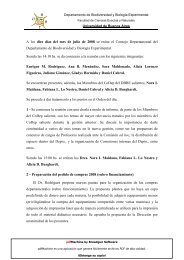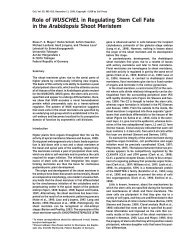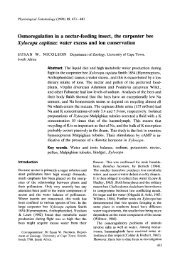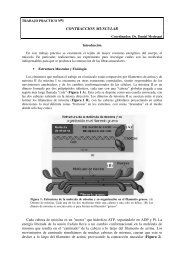The Aerobiology Pathway
The Aerobiology Pathway
The Aerobiology Pathway
You also want an ePaper? Increase the reach of your titles
YUMPU automatically turns print PDFs into web optimized ePapers that Google loves.
5.2.2. Late summer asthma<br />
Many people suffer from asthma at harvest time and on dry days many spores of<br />
Cladosporium and Alternaria are in the air and can cause allergic reactions. Some<br />
asthmatic patients associated their attacks with the proximity of ripening barley. During<br />
the summer of 1972 Frankland and Gregory (1973) had a Burkard trap running in the<br />
garden of a patient in Dorset whose asthma attacks seemed to be so triggered. Large<br />
numbers of two-celled ascospores were liberated at night, similar to those seen by Last<br />
(1955), and identified as spores of Didymella exitialis (Pl. 8.12 and 13) produced on<br />
barley. A scientist at Rothamsted observed that his asthma usually occurred in the late<br />
summer, particularly after rain. He responded to inhalation testing with D. exitialis<br />
extract with an asthmatic reaction and to a skin test with an immediate reaction. Other<br />
research workers and patients were tested and it was reported in <strong>The</strong> Lancet that D. exitialis<br />
seemed to be the cause of late summer asthma (Harries et al, 1985). Corden and<br />
Millington (1994) confirmed that Didymella spores can be found in the air after rain in<br />
the summer even in an urban area.<br />
5.2.3. Farmer’s Lung<br />
With the reduced risk of spontaneous fire in hay stacks following the widespread use of<br />
pickup balers, farmers were less cautious about making hay when it was too moist.<br />
Consequently many bales became very mouldy, increasing the problem of ‘Farmer’s<br />
Lung’, an allergic alveolitis disease. To identify the causal agent, Gregory assembled an<br />
interdisciplinary team, including a medical team at the Institute of diseases of the<br />
Chest, Brompton Hospital, funded by the Agricultural Research Fund (Hirst, 1990).<br />
Many types of hay were examined by tumbling samples in a perforated drum at the<br />
intake end of a small wind tunnel (Fig. 2.7) and the dust caught at the other end by a<br />
cascade impactor and Andersen sampler. Visual counts from the four traces of the cascade<br />
impactor gave up to 102 million fungal spores and 1200 million actinomycete spores<br />
per g (dry weight) of hays associated with Farmer’s Lung. <strong>The</strong> Andersen sampler<br />
(Andersen, 1958) allowed viable organisms to be collected dry and grown on different<br />
media at different temperatures. Predominantly thermophilic and mesophilic fungi and<br />
actinomycetes as well as bacteria were identified and counted (Gregory and Lacey, M.,<br />
1963a).<br />
Experimental batches of hay were baled at different moisture contents and monitored<br />
for temperature, biochemical changes and mould growth (Gregory et al., 1963).<br />
Hay baled at 40 % moisture heated to over 60˚C and contained a large flora of thermophilic<br />
fungi, particularly Aspergillus fumigatus (Pl. 10.16), Absidia spp. (Pl. 9.76-77),<br />
Mucor pusillus (Pl. 9.78), Humicola lanuginose (Pl. 10.43) and actinomycetes (Pl. 12.2-<br />
4). Extracts of the moulding hay were tested against serum from affected farmers, yielding<br />
positive reactions (Gregory et al., 1964). <strong>The</strong> actinomycetes <strong>The</strong>rmopolyspora polyspora<br />
and Micromonospora vulgaris were found to be a rich source of the Farmer’s Lung<br />
antigen (Pepys et. al., 1963). Consequently Farmer’s Lung disease was able to be registered<br />
as a prescribed disease under the National Insurance (Industrial Injuries) Act, 1964.<br />
THE AEROBIOLOGY PATHWAY 27


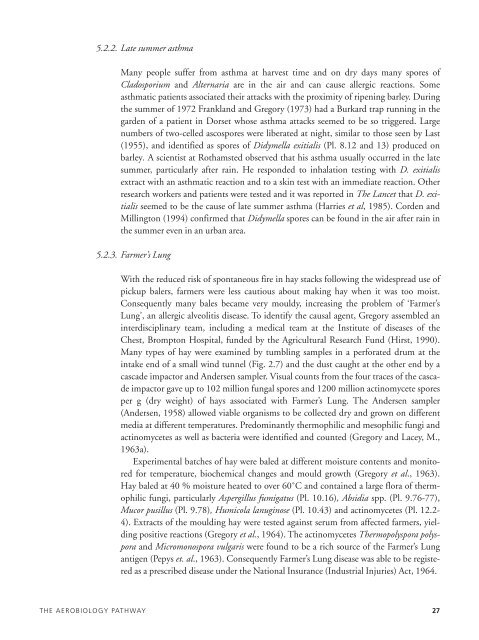

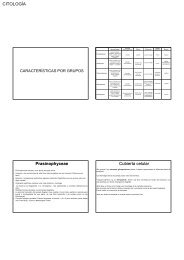


![Estructuras secretoras internas [4.64 MB]](https://img.yumpu.com/14294979/1/190x143/estructuras-secretoras-internas-464-mb.jpg?quality=85)
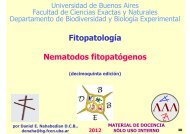
![anatomía y exomorfología [7.14 MB]](https://img.yumpu.com/12744163/1/190x143/anatomia-y-exomorfologia-714-mb.jpg?quality=85)
